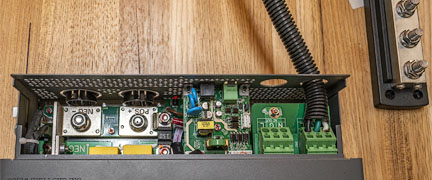
$220 SAVE $130 = 37.0% Western Digital 16.0TB Western Digital Ultrastar DC HC550 3.5-in… in Storage: Hard Drives
|

|

|

|

|
10 Kilowatt Lithium Battery System in Mercedes Sprinter: The Smart Way to Wire AC Shore Power Input

Photographer and cyclist and Mac expert and software engineer Lloyd Chambers is available for consulting on general Sprinter considerations at his usual consulting rates via phone, or in person in the Palo Alto, CA area. Save yourself hours and mistakes by discussing issues up-front. More about Lloyd....
Continued from 10 Kilowatt Lithium Battery System in Mercedes Sprinter: Challenges in Routing/Organizing/Placement.
This page discusses the smart way to wire AC shore power input using dual 2000 watt inverter/chargers, each capable of 80 amps DC charging (160 amps total, up to about 2700 watts AC input power).
While I had a 30 amp circuit installed at home, many households lack one and thus it is important to be able to use a 15 amp circuit when traveling to friends or family or otherwise (I carry two shore power cables, one for 15 amp, one for 30 amp).
Besides the bulk and lack of redundancy, a downside of a 3000 watt single inverter or similar is that there is no such control over the power drawn for charging, other than deprogramming the inverter/charger for a lower charge rate.
A single inverter delivers 80 DC amps at up to 14.6V, so that up to 1168 DC watts are sent into the batteries, which allowing for 85% efficiency equates to 1375 watts AC input. With two inverters delivering 160 DC amps total, that becomes as much as 2750 watts plus any load beyond the charging itself—far beyond the capability of a 15 amp household circuit. With dual inverter/chargers, it thus becomes necessary to plan for situations in which less than a 30 amp circuit is available.
Shore power wiring: use dual AC-IN plugs, one for each inverter/charger
Below, the wiring seen entering the inverter is a short stub cable whose other end plugs into an interior AC outlet which then is fed over 8 AWG wire to the shore power outlet on the outside of the van (and thence over an extension cored to shore power).
Two such AC-IN stubs feed feed from shore power, one plug for each inverter. Thus by unplugging one inverter, the shore power draw is cut in half, avoiding a blown circuit*.
* If dual inverter/chargers both draw ~1375 watts for charging, the breaker would instantly blow, so it becomes necessary to defeat one inverter/charger so that it does not attempt to charge, leaving the other inverter to do the job.
Continues below.

Sony A7R III + Zeiss Loxia 25mm f/2.4 Distagon
[low-res image for bot]
Hard wiring AC-in NOT a good idea
I ruled out hard-wiring AC-IN because I wanted to be able to feed AC power into one inverter only so that plugging into a 15 amp shore power circuit would not blow the circuit breaker, as per above. Done this way, I simply unplug one inverter when on a 15 amp circuit, thus preventing overloading a 15 amp shore power circuit. Hard-wiring both inverters makes this impossible and would require remembering down-programing the charge rate to avoid blowing a 15-amp circuit.
Wire gauge from the shore power inlet on van exterior to van interior
Wiring of 8 AWG is rated for 40 to 55 amps, depending on temperature, well beyond the capacity of a 30-amp outlet. Using 8 AWG wire from the shore power outlet to the interior is thus the smart move—who wants to ever have to open up a wall should wiring have an issue. Plus, what happens after 10 years of vibration from road use or with wire getting too hot from near-overload?
This was also done also so that a full 30 amps for dual 1500 watt space heaters directly from shore power could be drawn (unplugging and thus bypassing the inverter/chargers entirely), without worrying about stressing the internal wiring.
The choice of 10 AWG is right at the 30 amp limit, not a smart move given that it would be right at the limits. Adding in a 50-foot extension cable just to get to the van shore power input on the side of the van, the total scenario looks iffy as to robustness—insist upon 8 AWG interior AC wiring.
Seagate 22TB IronWolf Pro 7200 rpm SATA III 3.5" Internal NAS HDD (CMR)
SAVE $click



